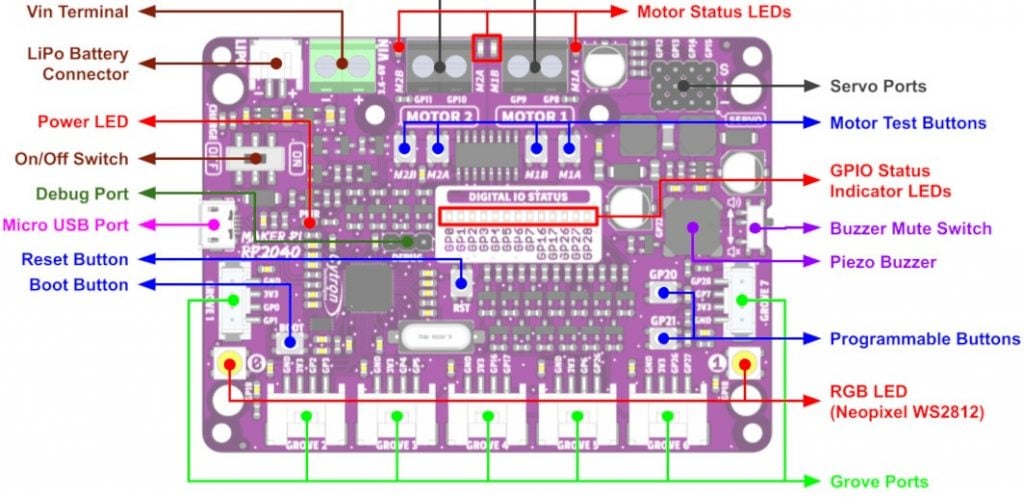Cytron’s Maker Pi RP2040 features the new Raspberry Pi RP2040 chip embedded on a robot controller board. The board comes with a dual-channel DC motor driver, 4 servo motor ports, and 7 Grove I/O connectors. Now you can build your new robot friend while simultaneously trying out the new RP2040 chip!
The onboard DC motor driver can control 2 x brushed DC motors or 1 x bipolar/unipolar stepper motor rated from 3.6V to 6V, providing up to 1A current per channel continuously. The built-in Quick Test buttons and motor output LEDs allow quick, convenient testing of the motor driver without writing code. V motor for both DC and servo motors depends on the input voltage supplied to the board.
Maker Pi RP2040 features all the goodness of Cytron’s Maker series products. It also has beaucoup LEDs (handy for troubleshooting and visual effects), can make quite some noise with the onboard piezo buzzer, and comes with pushbuttons ready to detect your touch.
There are three ways to supply power to the Maker Pi RP2040: via USB (5V) socket, with a single cell LiPo/Li-Ion battery, or through the VIN (3.6-6V) terminals. However, only one power source is needed to power up both controller board and motors at a time. Power supply from all these power sources can all be controlled with the power on/off switch onboard.
Cytron Maker Pi RP2040 is basically the Raspberry Pi Pico + Maker series’ goodness + Robot controller & other useful features. Software, firmware, libraries, and resources that are developed for Pico should work seamlessly with Cytron Maker Pi RP2040 too.
CircuitPython is preloaded on the Maker Pi RP2040, and it runs a simple demo program right out of the box. Connect it to your computer via USB micro cable and turn it on, you will be greeted by a melody tune and LEDs running light. Press GP20 and GP21 push buttons to toggle the LEDs on/off while controlling any DC and servo motors connected to it to move and stop. With this example code, you can test the board the moment it’s in your paws!.
Wanna use other programming languages? Sure, you are free to use MicroPython and C/C++ for Pico/RP2040. For those of you who love the Arduino ecosystem, take a look at this bit of official news from Arduino and also the unofficial Pico Arduino Core by Earle F. Philhower.
Pin Diagram:
- Powered by Raspberry Pi RP2040
- Dual-core Arm Cortex-M0+ processor
- 264KB internal RAM
- 2MB of Flash memory
- the exact same specifications with Raspberry Pi Pico
- Robot controller board
- 4 x Servo motors
- 2 x DC motors with quick test buttons
- Versatile power circuit
- Automatic power selection: USB 5V, LiPo (1-cell), or Vin (3.6-6V)
- Built-in 1-cell LiPo/Li-Ion charger (over-charged & over-discharged protection)
- Power on/off switch
- 13 x Status indicator LEDs for GPIO pins
- 1 x Piezo buzzer with mute switch
- 2 x Pushbutton
- 2 x RGB NeoPixel LED
- 7 x Grove ports (flexible I/O options: digital, analogue, I2C, SPI, UART…)
- Preloaded with CircuitPython by default
- Mounting holes
- 4 x 4.8mm mounting hole (LEGO-compatible)
- 6 x M3 screw hole
Features:
- Dual ARM Cortex-M0+ @ 133MHz
- 264kB on-chip SRAM in six independent banks
- Support for up to 16MB of off-chip Flash memory via dedicated QSPI bus
- DMA controller
- Fully-connected AHB crossbar
- Interpolator and integer divider peripherals
- On-chip programmable LDO to generate core voltage
- 2 on-chip PLLs to generate USB and core clocks
- 30 GPIO pins, 4 of which can be used as analogue inputs
- Peripherals
- 2 UARTs
- 2 SPI controllers
- 2 I2C controllers
- 16 PWM channels
- USB 1.1 controller and PHY, with host and device support
- 8 PIO state machines
Package Includes:
- 1x Maker Pi RP2040
- 4x Grove to Female Header Cable
- 1x Mini Screwdriver
- 1x Silicone Rubber Feet (Pack of 4)




















There are no reviews yet.